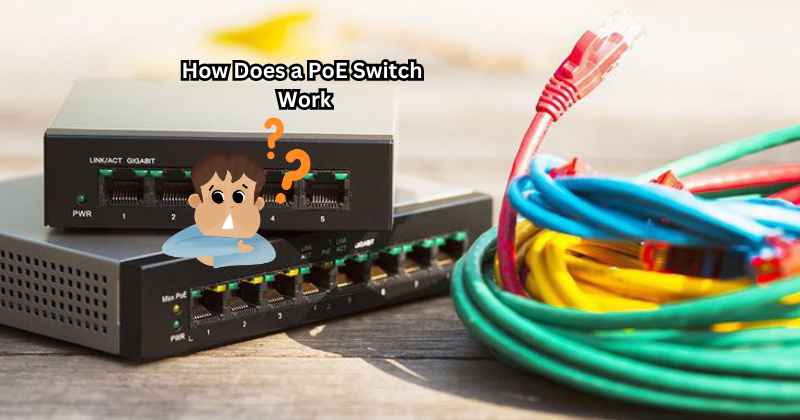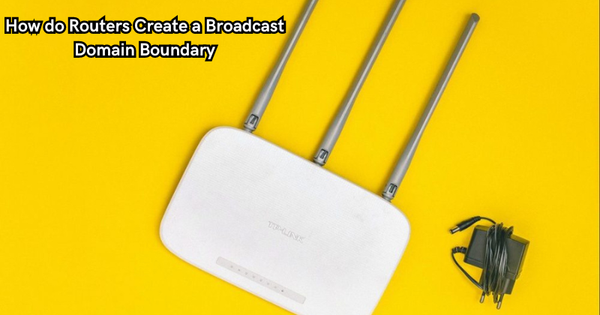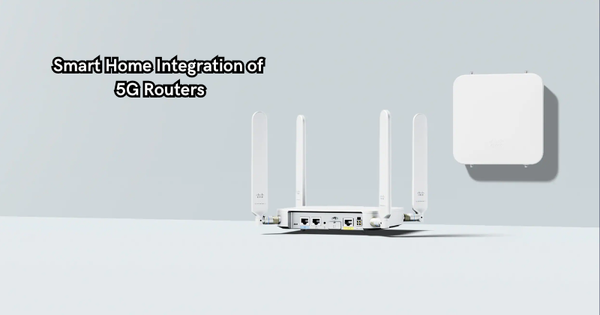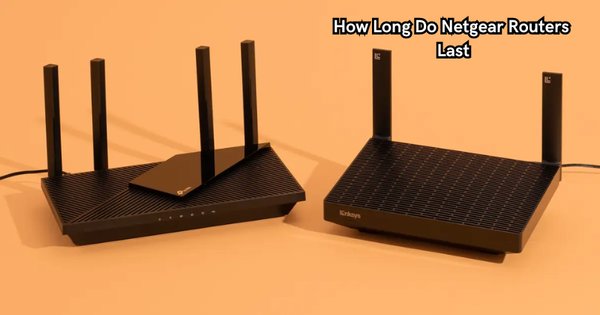A Power over Ethernet (PoE) switch is a smart device that combines the functionality of a network switch with the capability to power connected devices over the same Ethernet cable used for data transmission.
By integrating power and data into a single infrastructure, PoE switches simplify network installations, reduce cabling requirements, and enhance flexibility in device placement. The switch detects if a connected device is PoE-compatible and delivers power accordingly, eliminating the need for separate power sources.
This innovative technology streamlines network setups enhances efficiency and empowers organizations to deploy network-connected devices with ease and cost-effectiveness.
What Is PoE (Power Over Ethernet) Technology?
Power over Ethernet (PoE) technology enables power to be transmitted over standard Ethernet cables, which are typically used to connect network devices in a Local Area Network (LAN). In the early days of LANs, separate cabling was required for power and data.
With advancements in PoE technology, it is now possible to deliver both power and data over a single Ethernet cable, simplifying network infrastructure and reducing costs. Moreover, PoE also allows for remote power management and control, making it a popular choice in smart building applications.
What is a Network Switch?
A network switch is a networking device that connects devices on a computer network by using packet switching to forward data to its destination. Switches are essential components in modern networks and serve as the central point of connection for all network devices.
Network switches come in different types, including unmanaged switches, managed switches, and PoE switches. Unmanaged switches are simple plug-and-play devices that do not require any configuration, while managed switches offer greater control and customization options. PoE switches combine the functionality of a network switch with the capability to deliver power over Ethernet cables.
What is a Power over Ethernet (PoE) Switch?
A Power over Ethernet switch is a smart device that integrates the functionality of a network switch with the capability to deliver power over Ethernet cables. This eliminates the need for separate power sources, simplifying network installations and reduces costs. PoE switch supports PoE capability to supply power and data to devices such as IP phones, wireless access points, and network cameras.
PoE switches come in various configurations, including 8-port, 16-port, and 24-port options, allowing organizations to choose the right size for their network needs. Plus, PoE switches are also available at different speeds, such as 10/100 Mbps and Gigabit Ethernet, providing flexibility to support various devices and applications.
Types of PoE Switches
PoE switches are available in three different types based on the amount of power they can deliver – Type 1 (15.4 Watts), Type 2 (30 Watts), and Type 3 (60 Watts).
These various types of PoE switches cater to different devices with varying power requirements, from IP phones and wireless access points to surveillance cameras and IP speakers. VoIP phones, for instance, require only Type 1 PoE switches, while high-power devices like pan-tilt-zoom cameras may need a Type 3 switch.
Additionally, there are also PoE+ switches that can deliver up to 90 Watts of power for high-power devices such as pan-tilt-zoom (PTZ) cameras and video conferencing systems.
PoE switches may also come with other advanced features such as VLAN support, Quality of Service (QoS), and Power Budget Management to enhance network performance, prioritize traffic, and manage power consumption.
Features to Consider for PoE Switches
When choosing a PoE switch, there are several features to consider to ensure it meets the specific needs of the network. These include:
- Power Budget: The total amount of power that can be delivered by the PoE switch is referred to as its power budget. It is essential to determine the number and type of devices that need to be powered and select a switch with a sufficient power budget to support them.
- PoE Type and Power Output: As mentioned earlier, there are different types of PoE switches that can deliver varying amounts of power. It is crucial to select the right type of PoE switch to match the power requirements of the connected devices.
- Port Density and Speed: The number of ports and the speed at which data can be transmitted are also crucial considerations when choosing a PoE switch. Organizations should evaluate their current and future network needs to select a switch with an adequate number of ports and desired speed.
- Management Capabilities: Managed PoE switches offer advanced features such as remote management, VLAN support, and QoS to optimize network performance. It is essential to assess the network requirements and determine if these features are necessary.
Separate power cables and outlets for network devices can be a hassle to manage and often result in a cluttered and disorganized workspace. PoE switches eliminate the need for separate cabling, making network setups more efficient and cost-effective.
How Does a PoE Switch Work?
A PoE switch works by detecting if a connected device is PoE-compatible and delivering power accordingly.
The switch negotiates with the device to determine its power requirements and, based on that, delivers the appropriate amount of power over the Ethernet cable. This process eliminates the need for separate power sources and simplifies network installations.
Moreover, PoE switches also have built-in power management features that monitor and control the amount of power being delivered to each connected device, ensuring efficient use of available power without overloading the switch. This allows organizations to optimize their network setup and add new devices with ease.
What are the benefits of using a PoE Switch?
PoE switches offer numerous benefits for modern networks, including:
Simplifies Network Setup:
With PoE technology, organizations can eliminate the need for separate power sources and cables, simplifying network installations and reducing costs.
Cost-effective:
By combining power and data transmission over a single cable, PoE eliminates the need for additional infrastructure, saving on cabling and installation costs. Powered devices often have a lower upfront cost as well.
Flexibility and Scalability:
PoE switches come in various configurations and speeds, providing flexibility to support different devices and applications. Plus, their modular design allows for easy scalability as businesses grow.
Remote Management:
Managed PoE switches offer advanced management capabilities, allowing network administrators to monitor remotely. PoE devices can also be remotely rebooted if needed. A powered device can also be remotely shut down by the switch to conserve power during extended outages.
Reliable Power Supply:
PoE switches have built-in power management features that ensure a stable and reliable power supply to connected devices, reducing downtime and improving network performance.
Electrical power can also be backed up with a UPS (Uninterruptible Power Supply) for continued operation during power outages. A powered device can also be remotely shut down by the switch to conserve power during extended outages.
Safe and Secure:
PoE switches have built-in safeguards to prevent any power surges or overloads, ensuring the safety of connected devices. Plus, with data encryption capabilities, they also provide a secure network environment.
When Should You Use PoE Switches?
PoE switches are ideal for various scenarios, including:
- Remote Locations: PoE technology eliminates the need for separate power sources, making it an ideal solution for remote locations or areas with limited access to electrical outlets.
- Temporary Installations: With PoE, organizations can quickly deploy and remove temporary devices such as wireless access points or IP cameras without worrying about power **cables and outlets.
- Internet of Things (IoT) Deployments: With the rise of IoT devices, PoE switches provide a convenient solution for powering and connecting these devices to the network.
- VoIP Phone Systems: PoE switches are an excellent choice for VoIP phone systems as they offer a reliable power supply without any additional equipment or cables.
PoE-enabled devices and switches offer a simpler, more cost-effective, and efficient solution for powering and connecting network devices.
What are the Limitations of PoE Switches?
While PoE switches offer many benefits, they also have some limitations to consider:
- Distance: PoE switches are limited in the distance they can transmit power and data over Ethernet cables. Typically, a maximum of 100 meters is recommended for optimal performance.
- Power Limitations: As mentioned earlier, different types of PoE switches have varying power delivery capabilities. Organizations need to ensure that their switch has a sufficient power budget to support all connected devices.
- Compatibility: Not all devices are PoE-compatible, and some may require additional adapters or equipment to work with PoE switches.
These limitations should be carefully considered when choosing a PoE switch for your network.
FAQs
What is the disadvantage of the PoE switch?
As mentioned earlier, PoE switches have some limitations to consider. These include distance limitations, power limitations, and compatibility issues with non-PoE devices. Additionally, PoE switches may have a higher upfront cost compared to non-PoE switches.
Does the PoE switch reduce speed?
No, PoE technology does not affect the speed of data transmission over Ethernet cables. However, if a switch is powering multiple devices, it may have to allocate more power, which could potentially impact network performance.
Can all devices be powered by PoE?
No, not all devices are PoE-compatible. Some devices may require additional adapters or equipment to work with PoE switches. However, most modern network devices, such as IP cameras, VoIP phones, and wireless access points, come with built-in PoE capabilities.
Can I use a non-PoE switch with a PoE device?
Yes, you can use a non-PoE switch with a PoE device by using a PoE injector or splitter. A PoE injector supplies power to the device through an Ethernet cable, while a PoE splitter separates data and power signals from the Ethernet cable for use with non-PoE devices.
Conclusion
In conclusion, the seamless integration of power and data delivery in Power over Ethernet (PoE) switches revolutionizes network infrastructure by simplifying installations, enhancing flexibility, and optimizing efficiency.
By eliminating the need for separate power sources, PoE switches streamline network setups, reduce costs associated with additional cabling, and enable easier deployment of network-connected devices.
With PoE switches, organizations can effectively power and connect a wide range of devices, from IP cameras to wireless access points, creating a robust and versatile network environment. Embracing PoE technology is a strategic move towards building agile, efficient, and cost-effective networking solutions.



